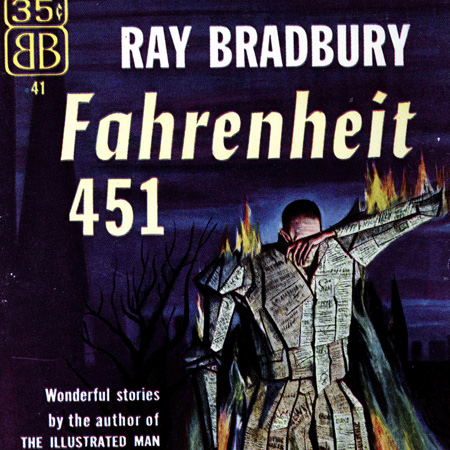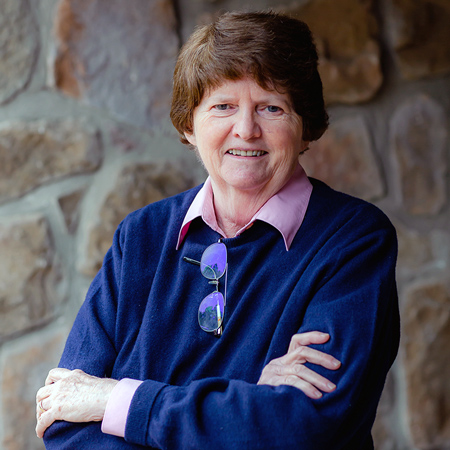Dear Mr. Bradbury
Newly acquired Ray Bradbury collection features books, pulps, fanzines and three decades of literary friendship
Posted on: October 28, 2021; Updated on: October 28, 2021
By Craig Brandhorst, craigb1@mailbox.sc.edu, 803-777-3681
When alumna Anne Farr Hardin was in ninth grade, she bought a paperback copy of The Illustrated Man, a short story collection by Ray Bradbury. The colorful cover had caught her eye, but the fantastical stories caught her imagination. She devoured it in a single sitting and hurried back for more. “I was just hooked after that,” she says.
And when Hardin says she was hooked, she means it. Just check out the massive trove of Bradbury publications and ephemera recently acquired from Hardin by the University of South Carolina’s Irvin Department of Rare Books and Special Collections, which is celebrating the acquisition with Bradbury 101, a new exhibition at the university’s Hollings Library.

The exhibit will feature a full case on Bradbury’s most famous novel, Fahrenheit 451, a couple of cases exploring the author’s lifelong fascination with the planet Mars and a representative range of the collection’s other holdings. Taken together, they provide an intriguing window on 20th century book and periodical publishing, particularly in the genres of fantasy and science fiction.
But what’s on display is just a hint of the many treasures tucked into Hardin’s vast collection. Researchers and other Bradbury devotees who take the time to dive into the holdings will discover every edition of Bradbury classics like Fahrenheit 451, The Martian Chronicles and Dandelion Wine plus vividly illustrated mid-century pulps like Amazing Stories and Weird Tales, mainstream magazines or “slicks” like Mademoiselle, McCall’s and Good Housekeeping, plus small-run fanzines predating the author’s international fame and acclaim.
In other words, it’s about as complete as complete gets — the collection even includes one of Bradbury’s bicycles — and it’s all the result of Hardin’s tireless literary sleuthing, which stretches back more than four decades.
“The classic line I’ve heard over and over is, ‘Oh, you’ll never find that one.’ Well, I found everything,” she says before catching herself: “OK, there’s still a few things out there. In fact, I found something new just a few weeks ago.”
But that’s the rare exception. If Hardin unearths anything else Bradbury at this point, it’s likely pretty obscure — a short pun that appeared in a pulp, for example, or a pseudonymous letter to the editor of a mimeographed fanzine.
“If I found a fanzine he was in, I’d go through every issue of that fanzine, page by page, and find clues about other things he had written, and then I would look for those,” says Hardin. “I would find them because they weren’t on anyone else’s radar. It was a great hunt.”

Amassing the Bradbury collection was not just a matter of scouring catalogs and eBay, though Hardin has done plenty of that over the years. It’s been a labor of love — one that grew out of a friendship with the author that began in 1982, when Hardin, ’78 MMusEd., ’90 Ph.D., was a middle school band director and the editor of the International Trumpet Guild Journal.
After a friend showed her a Bradbury poem about the jazz musician Louis Armstrong that had appeared in the Los Angeles Times, Hardin wondered if she could secure the rights to reprint it and contacted the paper about permissions.
“Then one day I came home and opened the mailbox, and there was a letter from Ray Bradbury,” she recalls. “I could hardly make it to the front door. He wrote that, yes, I could reprint it without any kind of fee. The only thing he wanted was six copies of the magazine when it came out.”
Needless to say, Hardin published the poem. But she also wrote back, initiating a correspondence, and an ensuing friendship, that would continue the rest of Bradbury’s life.
“That should have been it, but I didn’t want it to be it, so I searched for little ways to send him a note or ask him to autograph some bookplates that I could put in my Bradbury books,” she says. “And he always wrote back. I was always very formal — ‘Dear Mr. Bradbury…,’ and he’d write back, ‘Dear Ms. Farr…’”
Then one day he just came out and asked her why she kept writing to him, and she laid it on the line, explaining how she had been a tremendous fan of his work since she was a freshman in high school, how she had read everything he had ever written. After that, he became “Ray,” and she became “Anne.”
And the friendship blossomed. He began sending her signed books, magazines and other materials. She and her husband flew out to visit with him several times, and she eventually began assisting him at book signings, readings and other events. At one point, he even offered her a previously unpublished poem for the trumpet journal, “Ode to Orbicularis Oris,” about the muscle trumpet players use to make their embouchure. Another time, he gave the trumpet journal a shoutout on Tom Snyder’s late-night talk show.
“It was cool,” says Hardin. “But he loved the fact that I was a teacher. He loved the fact that I edited that magazine and that I wrote. He loved that I was a band director. Yes, I had been a high school fan, but we had a lot of things in common and we just found that out by chance over the years.”
The collection may have moved from Hardin’s home near Greenville to the Hollings Library, but Hardin isn’t so sad to see it go. On the contrary, she says she always intended for the university to get the collection, and she is honored to have it in good hands where others can enjoy it and learn from its contents.

Anne Hardin says she always intended for UofSC to get her Ray Bradbury collection.
Of course, she is also honored to have her long friendship with the author preserved. Along with the books and magazines, many of which are inscribed to Hardin, the collection contains every letter, note and postcard the two wrote to one another over 30-plus years, from that initial query and response to their last exchange. Alongside their personal back and forth, future researchers will also discover Bradbury reflecting on his work, bits about his life, even some playful doodles that provide a window into the author’s personality.
“The core of the collection is a collection of Bradbury, but it's also a collection of their friendship and their correspondence,” says reference and instruction librarian Michael Weisenburg, who co-curated the Bradbury 101 exhibit with cataloguer David Shay.
Hardin’s collection also adds to the university’s ever-expanding collection of popular 20th century authors whose appeal stretches beyond the printed page. Like James Ellroy and Elmore Leonard, two other prominent writers of popular fiction represented in the university’s special collections, Bradbury worked extensively in other media, including cinema, television and theater.
“As we’re collecting these really popular mid-20th century authors, we’re also expanding rare books beyond the idea of just books,” says Weisenburg. “It’s really this broader media landscape. How people consumed entertainment in the 20th century is becoming an increasingly important part of what we’re doing here.”
If you're going
The Bradbury 101 exhibit kicks off at 6 p.m. Nov. 4 with a talk by Anne Hardin, who will also discuss her new book, A Ray Bradbury Compendium.